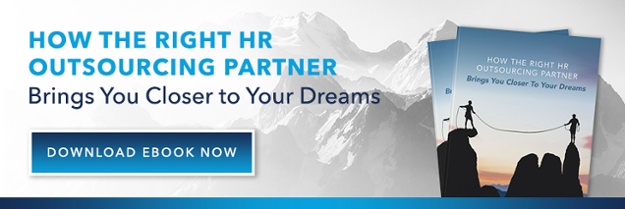Topic HR Strategy
Small vs. Large Businesses: How They Differ in HR Headaches

July 5, 2022 | By Questco

All Human Resource departments strive to balance employee requirements and the company's profitability. However, there is a significant difference between small and large businesses regarding HR challenges. Size, resources, organization, and state policies are all critical factors in determining the type of HR headaches an organization may face. In other words, some HR issues are more specific to small businesses but do not pose a problem for large corporations, whereas others may affect both.
According to a 2022 study by the National Association of Professional Employer Organizations (NAPEO), the priorities of small and large corporations differ based on their biggest human resource challenges. The survey used a "best-worst scaling" approach known as MaxDiff to show the differences between corporations based on the number of employees. It demonstrates a significant difference between HR headaches at small businesses vs. large organizations.
What Issues do Businesses Find Most Challenging?
Most HR issues in businesses come in several forms. They also differ in severity and complexity based on the company's challenges and scale.
According to the NAPEO survey, some of the most challenging issues for businesses are:
Purchasing and Administering Health Insurance
While health insurance may appear to be a major HR headache in large organizations, it is one of the most difficult challenges for businesses with fewer than 50 employees. According to a recent survey, approximately 59 percent of small-business owners face fierce competition with big firms on employee healthcare benefits. The main issue is that providing health benefits to employees is extremely costly, forcing some business owners to restrict insurance coverage for their workers.
As per the NAPEO report, small businesses, particularly those with fewer than 30 employees, have trouble purchasing health insurance. The key issue is cost variables and the number of workers since most companies don’t have enough employees to take advantage of economies of scale.
HR Technology
Despite being novel to the human resource department operations, HR technology has seen rapid advances in recent years. Modern HR tech is about more than just workflow automation and digitization. The innovation of technologies such as artificial intelligence has played a significant role in increasing the importance of HR technology in reshaping essential HR practices, ranging from talent acquisition to performance management.
Implementing HR technology has proven to be the most difficult challenge for companies with 100+ employees, followed by companies with 10-19 employees.
This may be because smaller businesses are still finding the right HR technology, whereas large corporations are attempting to customize HR technology to fit their needs. Large corporations may have also realized that HR technology has advanced significantly and that their current systems are outdated.
Compliance with Employment Regulations
Staying up to date with the evolving labor policies is challenging for medium-sized businesses (50 to 99 employees). Such corporations find it tedious to keep track of all local and state employment laws. They also lack the time and expertise to understand legal issues and nuances of regulations.
The employee count of 50 usually results in a new compliance burden, such as adhering to the Affordable Care Act. As a result, business owners find it difficult to adopt and implement new legislation that now pertains to them. Failure to fully abide by federal and state laws and regulations, on the other hand, can have severe repercussions for any business. This could result in audits, fines, and even litigation.
Workers Compensation Administration and Claims Management
Workers' compensation administration and claims management entail more than just offering a paycheck and covering the cost of living.
Human resources departments face challenges in effective workers compensation administration and claim management due to economic hardships and other business factors. And in particular, organizations with more than 50 employees face a slightly greater challenge. The likely reason is that you are more likely to face worker compensation claims as your company grows.
Payroll Tax Administration and Processing
The administration of employee pay based on employee status, salary, and deductions is known as payroll processing. Due to the numerous variables involved, such as wage levels, employee classifications, and terminations, pay processing can be challenging to manage.
According to the NAPEO survey report, payroll tax administration and processing were less complicated than the four HR issues listed above by businesses of all sizes. On the other hand, small businesses may find payroll administration and processing difficult because no one is dedicated to perform the task.
Retirement Plans such as 401(k)s
Two types of retirement plans are available for you and your employee; defined benefit plans and contribution plans. Based on your agreement with your employees, you can settle for a defined benefit plan that guarantees a specified monthly benefit at retirement. Or you go for a defined contribution plan requiring the business owner, the employee, or both parties to contribute to the employees' account under a plan at a set rate such as 5% of yearly income.
An excellent example of a defined contribution plan is 401(k), which is more difficult for large companies to implement than payroll. Medium-sized businesses, on the other hand, find it easier to provide retirement plans than to handle payroll processing. This could be because plan administration becomes more difficult as the number of employees grows.
PEO, a Perfect Solution for HR Headaches
Although all the above HR issues significantly affect business operation based on the organization's size, solving them is necessary for all firms, small or large. The best way to solve all HR headaches is to work with an HR outsourcing company capable of improving human resource management.
A Professional Employer Organization (PEO) is the ideal solution for HR issues. By partnering with an HR outsourcing firm, you will gain access to the PEO's master health insurance policy, which experts negotiated using economies of scale. You will also benefit from HR software as well as training for it. PEO will handle HR law and regulation compliance, employment tax filing, and payroll processing for you. Finally, your retirement plan is protected because the PEO serves as a co-sponsor to assist you in lowering your administrative costs.




